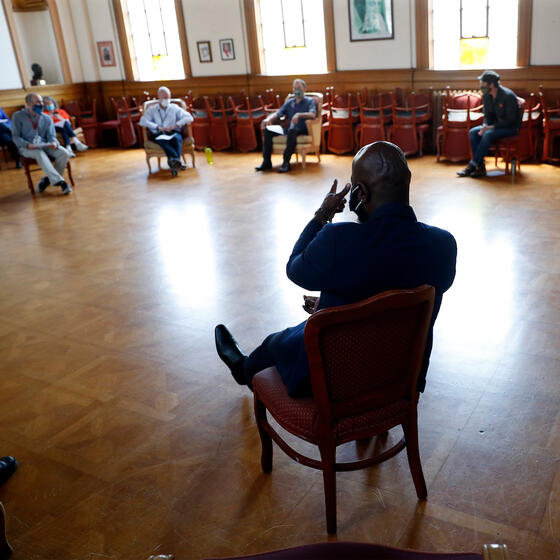Did ‘Lockdown Fatigue’ Diminish the Effectiveness of COVID-19 Restrictions?
In the first days of the COVID-19 pandemic, many of us assumed we would return to our usual routines in a few weeks. Instead, restrictions on group gatherings and businesses stretched on for months. Did they continue to save lives? In a new study, Yale SOM’s Matthew Spiegel examines how the effectiveness of restrictions evolved over time.

A staff meeting at a residential drug treatment program in San Francisco in May 2020.
In early 2020, as restrictions imposed to contain the coronavirus swept across the world, concerns about “lockdown fatigue” followed closely in their wake. As early as spring and early summer in the U.S., media commentators worried that lockdown policies were chafing, and that a critical mass of weary rule-breakers could render such policies ineffective.
But were the fears about the diluting effects of lockdown fatigue warranted? After all, it was also conceivable that, broadly speaking, people would follow the rules more diligently as death counts climbed. A new study by Yale SOM’s Matthew Spiegel sets out to find the answer.
The new paper builds on past research in which Spiegel teamed up with his Yale SOM colleague Heather Tookes to evaluate the effectiveness of specific COVID-19 restrictions. The researchers found that while some policies (like mask mandates, restaurant and gym closures, and the shuttering of high-risk businesses like movie theaters and bowling alleys) undoubtedly saved lives, others proved harmful, actually worsening the death rate (counterproductive policies included closing retail stores and imposing 100-person limits on gatherings). Spiegel says he believes that these policies backfired by pushing people to embrace behavior even riskier than had been disallowed—for example, a person might have invited 15 friends over to their house because an outdoor baseball game was canceled.
Spiegel’s new project pushes the researchers’ initial question about policy effectiveness a step further: some of the policies may have helped at first—but did that helpfulness last?
“Part of the policy problem is, how long will people pay attention to you?” Spiegel says. “If the answer is, after a while they stop paying attention in a way that’s effective, then we potentially have policies that do [economic and psychological] damage without any real benefit.”
Like his collaborations with Tookes, Spiegel’s new project drew its data from the Yale SOM-Tobin Center State and Local COVID Restriction Database, which contains uniquely granular information about COVID-19 restrictions on a county-by-county basis across the U.S. The database is one of the few to even include partial restrictions (like capacity limits).
In line with commentators’ early fears, Spiegel found that, indeed, the initial effects of pandemic restrictions did become less potent as they persisted—suggesting that people’s resolve to follow the rules diminished over time. This was true whether the policies were associated with lower future COVID-19 deaths or higher future deaths; over time, their effectiveness moved to zero.
Stay-at-home orders prompted resistance most quickly, losing their impact after about 7 weeks. Full shutdowns of bars maintained their effectiveness for about 17 weeks—and partial (25%) capacity rules at bars stayed effective even longer, for almost 23 weeks.
In the course of the research, Spiegel wondered if the speed and intensity of lockdown fatigue could be related to economic hardship. He ran tests to determine whether the state of the local economy, as measured by its GDP growth in 2019 or 2020, bore any influence on its residents’ lockdown fatigue. He found no relationship.
“But that tells me something.” he says. “Fatigue is not related to the local economy and what's happening there—but to other forces.”
I think that part of the lesson here for the next pandemic is, if we focus on restrictions that we know really work and save lives, we’ll potentially do a lot of good—and maybe the fatigue won’t set in as quickly. Because I suspect that the more things you lock down, the faster the onset of fatigue.
Interestingly, Spiegel did find that people in urban areas remained cooperative with the lockdown policies for a longer duration than those in rural areas. He hopes future research can untangle the reasons why, and illuminate the factors contributing to better adherence among people in more densely populated regions.
After all, Spiegel says, another pandemic could rear up sometime in the future, forcing societies to take similar precautions. If that happens, the lessons from the COVID-19 pandemic need to be clear and widely understood, so that deaths—as well as economic and psychological strife—can be minimized.
“I think that part of the lesson here for the next pandemic is, if we focus on restrictions that we know really work and save lives, we’ll potentially do a lot of good—and maybe the fatigue won’t set in as quickly,” Spiegel says. “Because I suspect that the more things you lock down, the faster the onset of fatigue.”
One sobering upshot of Spiegel’s findings is that policymakers may need to acknowledge that no matter how effective their set of pandemic lockdown policies, those restrictions are eventually bound to lose their effectiveness.
“Whether a restriction is good or bad,” Spiegel writes, “this paper indicates that its ability to impact viral transmission disappears over time. From a policy perspective, this implies that even if government officials can identify lockdowns that will initially limit the virus’ spread, they will eventually cease working. At that point, there are costs but no benefits, and the limits should be lifted.”